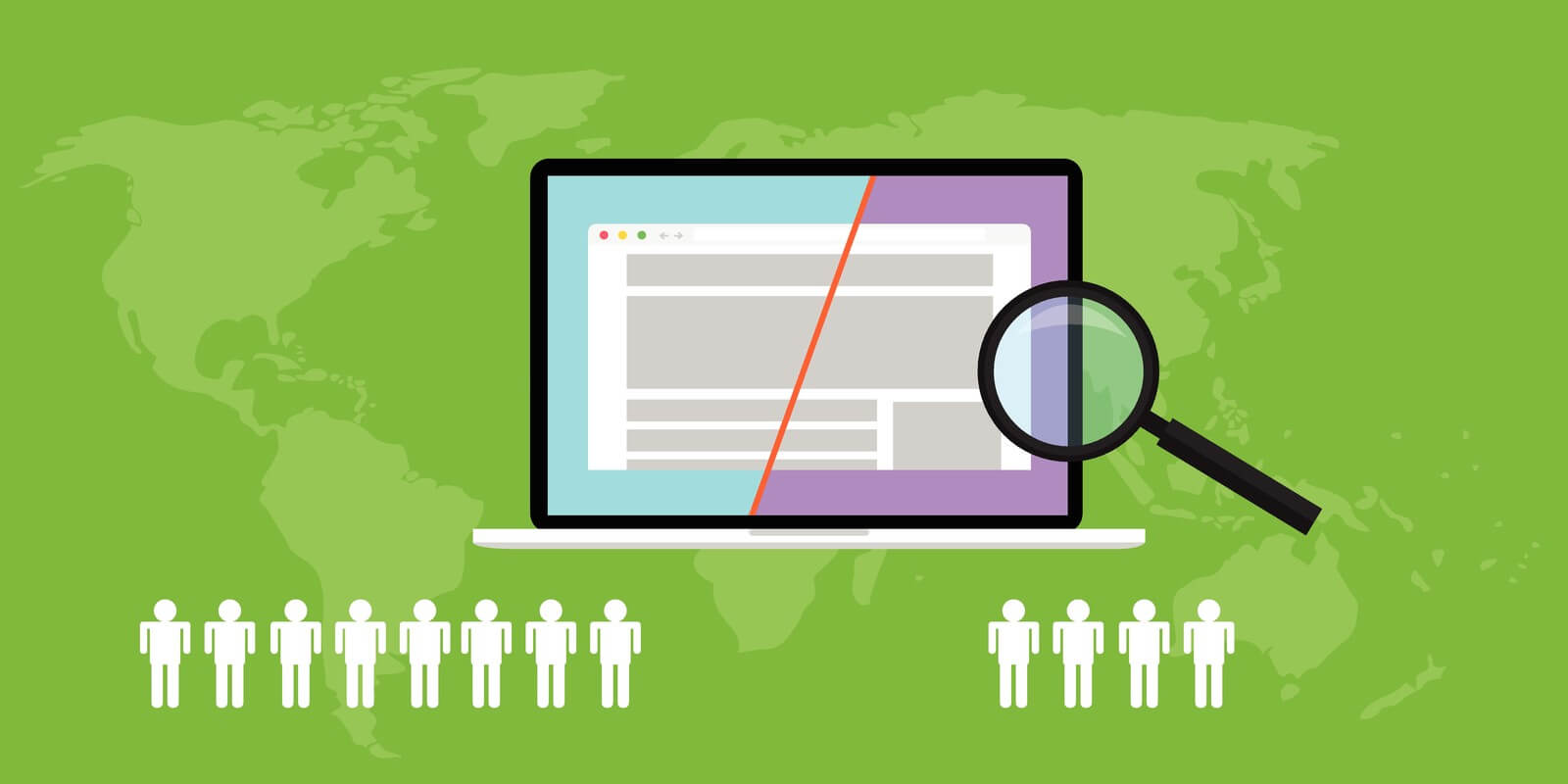A/B testing, also known as split testing, involves comparing two versions of a web page to see which one performs better. It's a way to test changes to your page against the current design and determine which one produces better results.
With the explosion of ecommerce and the growing trend of online shopping, A/B testing has become a crucial technique for refining the online shopping experience by improving product pages, the checkout process, and other essential aspects.
What is A/B testing?
A/B testing, or split testing, is a form of random trial where two or more variants of a factor (web page, email, ad, etc.) are shown to distinct groups of a target audience concurrently to ascertain which version produces the most significant impact and supports business KPIs.
The original "A" version acts as a control, while the "B" version is the altered variant. Visitors are randomly allocated to either the A or B version, and each version's performance is evaluated based on specific metrics like conversion rates, click-through rates, or bounce rates.
By comparing the performance of both versions, website owners can make data-informed decisions to optimize their website or marketing campaigns.
Why A/B Testing Matters for eCommerce
Every interaction a visitor has with your eCommerce website can influence their buying decision. From the placement of your call-to-action (CTA) buttons to the color scheme of your site, even the smallest details can have a significant impact on conversion rates.
By using A/B testing, you can experiment with different elements and layouts and use data-backed decisions to improve your site's performance. This can lead to increased conversions, better customer engagement, and ultimately, more sales.
- Increased conversion rates:
An ecommerce platform can enhance its conversion rate by implementing A/B tests on different website elements or landing pages. - Enhanced user experience:
A/B testing assists with identifying and removing website or landing page features that confuse or displease users, resulting in a superior user experience. - Increased revenue:
By enhancing conversion rates and user experience, A/B testing can contribute to higher revenue for an ecommerce website. - Deepened understanding of customers:
Through A/B testing, website owners discover which components of their website or landing pages connect with customers, facilitating a more comprehensive understanding and satisfaction of their needs. - Personalization:
Ecommerce retailers can boost their conversion rates by delivering a more tailored experience to different user segments. - Data-based decision-making:
With the support of A/B testing, ecommerce businesses can make informed choices about improving their websites and landing pages.
Types of A/B Testing for Ecommerce
Understanding these different types of A/B testing can help devise more effective and data-driven strategies to optimize their website and email campaigns, ultimately leading to improved user experience and boost conversion rates.
Below are 7 distinct types of A/B testing that can be leveraged to optimize their website:
- Split URL Testing:
This approach requires the creation of two separate versions of a webpage or landing page, directing visitors to each version subsequently. For example, an ecommerce store could create two product page variants—one featuring a product demonstration video and one without. Half of the traffic is directed to the video page, and the other half to the non-video page. The aim is to identify which version achieves higher conversion rates. - Multivariate Testing:
Multivariate testing entails implementing multiple changes to a webpage or landing page and assessing various combinations of those changes to identify the most effective version. In essence, it allows you to assess the efficiency of multiple variations of elements like headlines, images, and call-to-action buttons on the homepage. - A/B/n Testing:
This testing type is akin to A/B testing, but it accommodates testing more than two versions of a webpage or landing page concurrently. For instance, designing three unique versions of a checkout page and test them simultaneously to determine which variant records the highest conversion rate. - A/B/X Testing:
This testing method is similar to A/B/n testing, but it involves different changes. For instance, an online store might generate three different variations of its checkout page and implement A/B tests to determine which version leads to the best conversion rate. These variants could include a video guide, a chatbot assistant, and a conventional form. - Personalization Testing:
Personalization testing involves creating distinct versions of a webpage or landing page tailored to different visitor segments—such as location or browsing history—and evaluating their respective conversion rates. For example, an online store might create two homepage versions, one catering to U.S. customers and one for Canadian customers, to assess which one garners the most favourable response. - Behavioural Testing:
Behavioural testing involves observing visitor behaviour on a webpage or landing page, utilizing that data to implement changes, and testing different hypotheses based on those observations. For instance, online retailers could monitor how far their customers scroll to assess the effectiveness of various page designs and call-to-action placements for enhancing conversions. - Email A/B Testing:
In addition to testing website elements, can also leverage A/B testing for email marketing campaigns. This could involve testing different subject lines, email layouts, content, images, or CTA buttons to identify which version leads to higher open rates, click-through rates, or conversions.
Step-by-Step Strategies for Effective A/B Testing
The first step towards conducting an effective A/B test is to identify areas that require improvement. You can use customer feedback, website analytics, and heatmap tools to pinpoint issues that could potentially be impacting your conversion rate.
Once you've identified these problem areas—be it a high cart abandonment rate, a low click-through rate on a particular CTA, or a poorly performing landing page—it's time to set clear, specific goals for your A/B test. The goals should be linked to the issue at hand, such as "increase the click-through rate on the CTA by 15%."
With your goal set, it's now time to formulate hypotheses about what changes could potentially improve your targeted metric. These hypotheses should be based on user behaviour data and insights. For example, if your goal is to improve the click-through rate of a CTA, a hypothesis could be "Changing the CTA button colour to red will increase the click-through rate." Following this, you create the test variations—one version keeping the original element (control) and another incorporating the proposed change (variant).
After setting up the variations, you need to choose a suitable A/B testing tool to run your test. The tool will randomly expose your website visitors to the control and variant versions and track their behaviour. This phase should be long enough to gather sufficient data for reliable results—typically a couple of weeks or until you have a statistically significant result.
Once the test period is over, it's time to analyze the data. The variant that performs better in terms of your set goals will be the winner. Insights from the tests should inform changes to your ecommerce site, ensuring every decision is data-driven and aimed at improving the user experience and conversions.
- Step 1: Pinpoint the Trouble Spots
Tools such as customer surveys, analytics, heatmaps, or direct communication with your customer service and sales teams can help identify problems. These could range from visitors leaving before scrolling halfway down the category page to obstacles in the checkout process. - Step 2: Select the Right Metric
The metric you select should align with the goals you aim to achieve through A/B testing. Tracking multiple metrics can potentially lead to incorrect conclusions. For instance, if the problem identified is related to checkout friction, the conversion rate should be the metric you monitor. - Step 3: Formulate a Hypothesis
Once you've set your goal, the next move is to develop data-backed hypotheses on improvements that could yield superior results. For example, you might speculate that integrating a one-page checkout system could enhance conversions by up to 21.8%. - Step 4: Determine the Key Variables
Pinpoint the variables you want to test, such as messaging, promotional offers, or segmentation parameters. In line with our previous example, key variables might include various components of the checkout process, like the checkout form, payment options, and security assurances. - Step 5: Develop Variations
Craft variations for each variable you're testing. For instance, you could compare the performance of two distinct checkout forms. - Step 6: Select a Sample Size
To ensure reliable results, determine the number of participants in each test group. Julian Shapiro underscores the necessity of an adequately large sample size for valid experimental outcomes. For example, to statistically validate a conversion increase of 6.3% or more, a test needs 1,000+ visits. A test needs 10,000+ visits to statistically validate a 2%+ increase. - Step 7: Execute Tests and Monitor Results
Implement your A/B tests and track the results to identify the superior-performing variation. Google advises continuing an experiment until one of the following conditions is met: two weeks have passed to accommodate for weekly web traffic variations, or at least one variant has a 95% probability of outperforming the baseline. - Step 8: Evaluate and Enhance
Leverage the insights gained from your A/B tests to hone your strategy. This could mean refining your segmentation parameters, personalization methods, or messaging to boost your campaign's effectiveness. - Step 9: Maintain a Cycle of Testing and Optimization
Keep testing and refining your strategy regularly to ensure you consistently provide the most effective customer experiences.
A/B testing is not a one-time process but a continual one. Always be on the lookout for elements to test and optimize as customer behaviour and market trends evolve.
A/B Testing Tools
Tools can help ecommerce businesses conduct effective A/B testing to enhance their websites, improve user experience, and boost conversion rates.
- Optimizely: Optimizely is a powerful A/B testing tool that allows you to create and edit your tests easily. It provides multi-channel optimization across web and mobile apps and has robust reporting features.
- Visual Website Optimizer: VWO is a comprehensive A/B testing tool that includes a variety of features such as heatmaps, click maps, session recordings, and funnel analysis in addition to A/B, multivariate, and split URL testing.
- Unbounce: Unbounce is primarily a landing page builder, but it also includes built-in A/B testing capabilities. It's a great choice if you're looking to test different landing page designs.
- AB Tasty: AB Tasty offers a wide range of testing options, including A/B, multivariate, split, and funnel testing. It also provides personalization features and has a user-friendly interface.
- Omniconvert: This tool allows for A/B testing, multivariate testing, and personalization. It also provides survey functionality to gather visitor feedback.
- Adobe Target: Part of Adobe's Marketing Cloud suite, Adobe Target offers a wide range of testing and personalization features. It's particularly effective for large enterprises with complex testing needs.
- Hotjar: While not a traditional A/B testing tool, Hotjar offers heatmaps, session recordings, and surveys that can provide valuable insights to inform your A/B tests.
If you want your website or online presence to perform at its best, A/B testing is an absolute must. Remember to have a well-defined hypothesis to test, to focus on just one variable at a time, and to amass enough data to draw meaningful conclusions.
Initiate your own A/B tests using the samples and advice offered here as a foundation. You can take your brand’s online presence to the next level with the help of A/B testing if you're patient and persistent.




